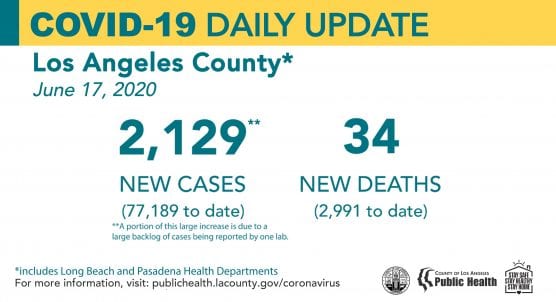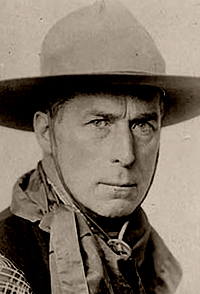The Los Angeles County Department of Public Health on Wednesday confirmed 2,129 new cases of COVID-19 and 34 new deaths due to the virus countywide, including the 13th fatality at Henry Mayo Newhall Hospital, bringing the Santa Clarita Valley COVID-related death toll to 27 residents.
A total of 2,793 confirmed COVID-19 cases have been reported in the Santa Clarita Valley since the pandemic began, 13 more local cases than reported Tuesday.
In the SCV, of the 27 people who have died of the virus to date, 21 resided in the city of Santa Clarita, 2 in Acton, 1 in Castaic, 1 in unincorporated Valencia, 1 in unincorporated Bouquet Canyon, and 1 in a community not yet named.
A portion of the large L.A. County increase is due to a backlog of about 600 test results being reported by one lab, Public Health reported.
Countywide, Public Health has reported 77,189 positive cases of COVID-19 and a total of 2,991 deaths to date. Ninety-three percent of people who died had underlying health conditions.
Statewide, the California Department of Public Health has reported a total of 157,015 confirmed cases and 5,208 deaths from COVID-19. Currently, there are 3,421 confirmed hospitalizations and 1,109 ICU hospitalizations.
As of June 16, local health departments have reported 12,459 confirmed positive cases in health care workers and 76 deaths statewide.
California’s positivity rate – a key indicator of community spread – remains stable in the 14-day average. Hospitalization rates remain stable over the long-term while showing a slight uptick in the 14-day average.

Santa Clarita Valley Wednesday Update
Of the 2,793 cases reported to Public Health for the SCV to date, the community breakdown is as follows:
City of Santa Clarita: 917
Castaic: 1,724 (includes Pitchess Detention Center and North County Correctional Facility*)
Stevenson Ranch: 41
Canyon Country (unincorporated portion): 39
Val Verde: 23
Acton: 17
Valencia (unincorporated portion west of I-5): 12
Agua Dulce: 9
Saugus (unincorporated portion): 5
Elizabeth Lake: 3
Bouquet Canyon: 1
Lake Hughes: 1
Newhall (Unincorporated portion): 1
*Note: The county is unable to break out separate numbers for Castaic and PDC/NCCF because the county uses geotagging software that cannot be changed at this time, according to officials. Click here for the LASD COVID-19 dashboard.
Henry Mayo Wednesday Update
Henry Mayo Newhall Hospital reported its 13th COVID-related death on Wednesday, June 17, according to hospital spokesman Patrick Moody.
As of Wednesday, of the 2,343 persons tested at Henry Mayo to date, 249 tested positive, 2,328 were negative, 77 were pending and 7 patients were hospitalized in a dedicated unit receiving ICU-level care. A total of 94 COVID-19 patients have been discharged so far.
Discrepancies in the testing numbers are due to some patients being tested more than once, Moody said.
The hospital is now releasing numbers on a weekly basis (Wednesdays) unless there is a drastic change in the number of cases or a death has been confirmed, he said.

L.A. County Demographics
Twenty-three people who died were over the age of 65 years old, seven people who died were between the ages of 41 and 65 years old, and four people who died were between the ages of 18 and 40 years old. Twenty-three people had underlying health conditions including 17 people over the age of 65 years old, four people between the ages of 41 to 65 years old, and two people between the ages of 18 and 40 years old.
One death was reported by the city of Long Beach and one death was reported by the city of Pasadena.
Upon further investigation, 24 cases and two deaths reported earlier were not L.A. County residents.
There are 1,420 people currently hospitalized; 28% of them are in the ICU and 22% are on ventilators.
L.A. County Testing; Nursing Facilities
Testing capacity continues to increase in L.A. County, with testing results available for nearly 854,000 individuals and 8% of people testing positive.

With support from Public Health, the Los Angeles County Department of Health Services and the city of Los Angeles, testing of all residents and staff has been completed in all 315 skilled nursing facilities in L.A. County, not including Long Beach and Pasadena. This includes facilities that have had outbreaks and facilities that have not yet had outbreaks.
Of the over 30,000 test results currently available from among both residents and staff, 6% tested positive for COVID-19 and 78% of the people testing positive were asymptomatic or pre-symptomatic.
Additionally, Public Health continues to see a decrease in skilled nursing facilities’ seven-day rolling average of daily COVID-19 deaths. In early May, the average daily deaths at skilled nursing facilities was 25 or 26 and in early June the average daily deaths at skilled nursing facilities was 16 or 17.

“Our hearts go out to the many families who have lost people they love to COVID-19. You are in our thoughts and prayers every day. We are so sorry for your loss,” said Barbara Ferrer, PhD, MPH, MEd, Director of Public Health.
“While many may be feeling relief that more businesses and facilities are opening, and that people are going back to work, please remember that the key to moving through our recovery journey successfully is to look out for one another,” Ferrer said. “This means practicing physical distancing as much as possible and wearing a cloth face covering whenever you are around other people who are not from your household. This includes when you are walking along a sidewalk or standing in line at the store; if you will pass by others, please be wearing your face covering.”
Stage 3 Modified Health Order
Public Health issued a modified Health Officer Order that allows select sectors to reopen once they implement the required protocols for infection control and distancing.
The Health Officer Order contains protocols for all businesses that are permitted to reopen to ensure it is done as safely as possible for employees, customers and residents.
Employees and visitors to these businesses need to wear a cloth face covering when around other people and practice physical distancing of at least 6 feet at all times. Some employees may also be required to wear face shields.
It is important for everyone to follow the directives and to do their part every day to keep everyone as safe as possible.

Best Protections
Because this virus has not changed and is still easily transmitted among people in contact with each other, the best protection against COVID-19 continues to be to wash your hands frequently, avoid touching your eyes, nose, and mouth with unwashed hands, self-isolate if you are sick, practice physical distancing, and wear a clean face covering when in contact with others from outside your household.
It’s important if someone thinks they could be positive for COVID-19 and are awaiting testing results, to stay at home and act as if they are positive. This means self-isolating for 10 days and 72 hours after symptoms and fever subside, or until they receive a negative result.
If a person tests positive for COVID-19, they should plan on receiving a call from a contact tracer to discuss how to protect themselves and others, to find out where they may have been, and who they were in close contact with while infectious.
People who have underlying health conditions remain at much greater risk for serious illness from COVID-19, so it will continue to be very important for the county’s vulnerable residents to stay at home as much as possible, to have groceries and medicine delivered, and to call their providers immediately if they have even mild symptoms.
The Reopening Protocols, COVID-19 Surveillance Interactive Dashboard, Roadmap to Recovery, Recovery Dashboard, and additional things you can do to protect yourself, your family and your community are on the Public Health website, www.publichealth.lacounty.gov.
Here’s the L.A. County incident report for Wednesday, June 17:
[Open .pdf in new window]

California Demographics
Overall, for adults 18 and older, Latinos, African Americans and Native Hawaiians and Pacific Islanders are dying at disproportionately higher levels. The proportion of COVID-19 deaths in African Americans is about double their population representation across all adult age categories.
For Native Hawaiians and Pacific Islanders, overall numbers are low, but there is nearly a four-fold difference between the proportion of COVID-19 deaths and their population representation. More males are dying from COVID-19 than females, in line with national trends.
More information is available at COVID-19 Race and Ethnicity Data.
Testing in California
As testing capacity continues to increase across the state, the California Department of Public Health is working to expand access to COVID-19 testing. Testing should be used for medical evaluation of persons with symptoms of COVID-19 as well as for efforts by public health agencies and essential employers to prevent and control the spread of COVID-19.
As of June 16, there have been 2,997,988 tests conducted in California and reported to the California Department of Public Health. This represents an increase of 60,233 tests over the prior 24-hour reporting period.
These numbers include data from commercial, private and academic labs, including Quest, LabCorp, Kaiser, University of California and Stanford, and the the 25 state and county health labs currently testing.
More than 85 community testing sites also offer free, confidential testing: Find a COVID-19 Testing Site.

Protect Yourself and Your Family
Every person has a role to play. Protecting yourself and your family comes down to common sense:
Staying home except for essential needs/activities following local and state public health guidelines when patronizing approved businesses. To the extent that such sectors are re-opened, Californians may leave their homes to work at, patronize, or otherwise engage with those businesses, establishments or activities.
* Practicing social distancing.
* Wearing a cloth face mask when out in public.
* Washing hands with soap and water for a minimum of 20 seconds.
* Avoiding touching eyes, nose or mouth with unwashed hands.
* Covering a cough or sneeze with your sleeve, or disposable tissue. Wash your hands afterward.
* Avoiding close contact with people who are sick.
* Staying away from work, school or other people if you become sick with respiratory symptoms like fever and cough.
* Following guidance from public health officials.

What to Do if You Think You’re Sick
Call ahead: If you are experiencing symptoms of COVID-19 (fever, cough or shortness of breath), call your health care provider before seeking medical care so that appropriate precautions can be taken. More than 85 community testing sites also offer free, confidential testing: Find a COVID-19 Testing Site.
New Data Portal
The state has launched a new, user-friendly data portal at COVID-19 Statewide Update that tracks COVID-19 cases statewide and by county, gender, age and ethnicity. The portal also outlines statewide hospitalizations and testing efforts. The data presented on the portal will be updated daily and will include additional information as it is available.
For more information about what Californians can do to prevent the spread of COVID-19, visit Coronavirus (COVID-19) in California.
California continues to issue guidance on preparing and protecting California from COVID-19. Consolidated guidance is available on the California Department of Public Health’s Guidance webpage.
Like this:
Like Loading...
Related





 Tweet This
Tweet This Facebook
Facebook Digg This
Digg This Bookmark
Bookmark Stumble
Stumble RSS
RSS


































REAL NAMES ONLY: All posters must use their real individual or business name. This applies equally to Twitter account holders who use a nickname.
0 Comments
You can be the first one to leave a comment.